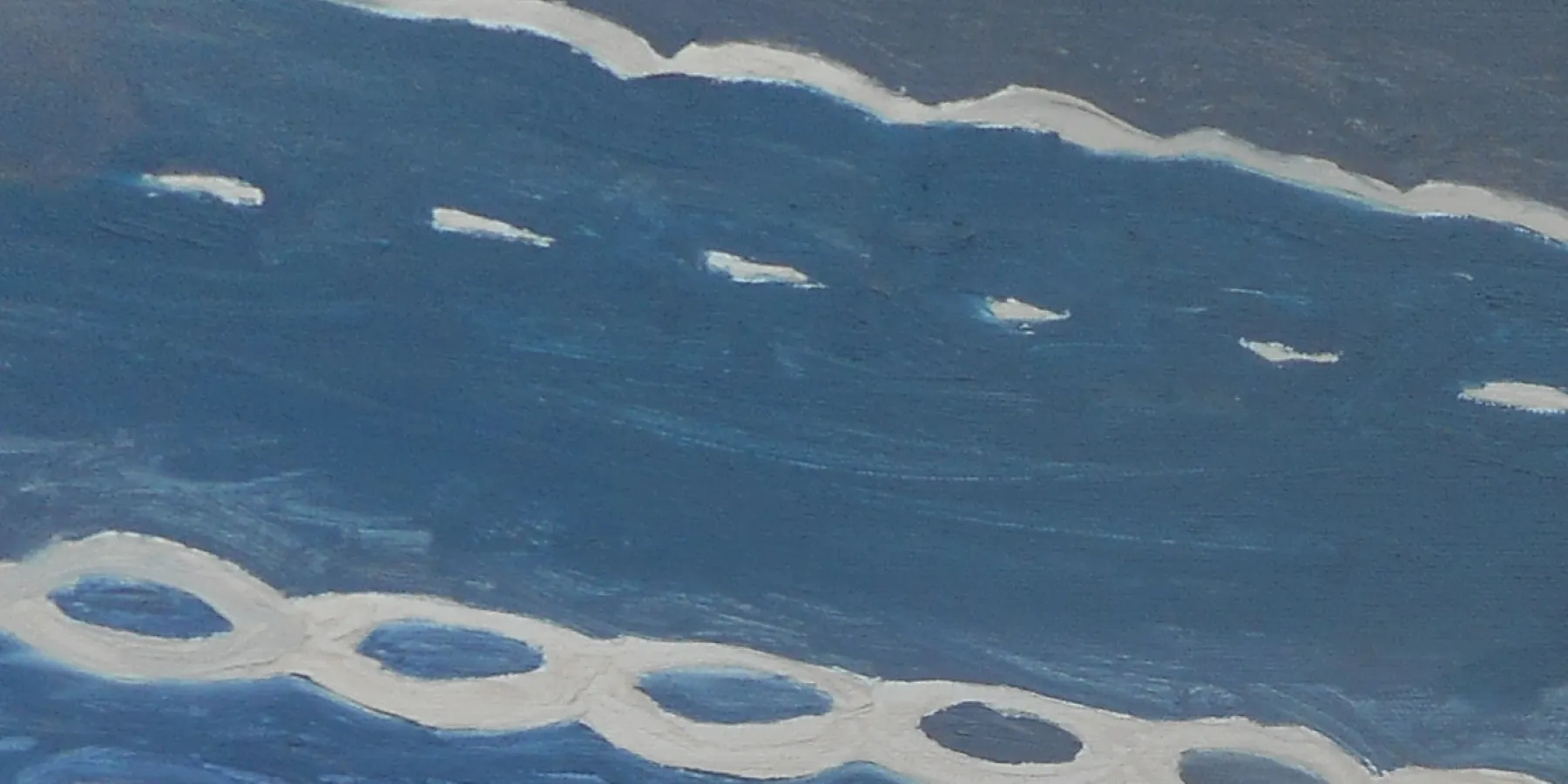Abstract
Background: Indigenous peoples experience an inequitable burden of cancer compared with other populations. The arts can serve as a culturally relevant cancer intervention and research method.
Methods: A scoping review was conducted to determine how arts-based research methods have been used to address cancer in Indigenous peoples. Literature searches identified 129 publications; 32 were selected for review. The following data were extracted: communities employing arts-based cancer research, cancer control continuum stages, cancer types, art forms, and methodologies.
Results: Most studies were conducted in the United States. Art as research and sound art forms were the most utilized arts-based methods. Cancer types and control continuum stages were not often specified.
Conclusions: Culturally responsive, arts-based methods can enhance research and education across the cancer-control continuum with Indigenous populations.
Art as Data Sources
The arts can serve as the core of an intervention (eg, art therapy, narrative medicine) and as a method of research (ie, arts-based research). There is a growing movement to diversify the academic research environment by treating the arts as an empirical source of information and to expand our understanding of what art is to include what art does.1 Arts-based research (ABR), a method of inquiry that recognizes artistic expressions as ways of knowing, uses artistic expression and the artistic process as a primary mode of inquiry to understand and examine the experience of both researchers and research participants.1 In particular, ABR has been used to explore, illustrate, define, treat, and explain cancer across the control continuum.2,3,4,5
In health research, ABR is commonly utilized with Indigenous populations as a culturally appropriate means of engagement.6,7,8 A recent systematic review of Indigenous research methods (IRMs) found that the following most cited methods were general Indigenous frameworks: Western methods in an Indigenous context, community-based participatory research, storytelling, and culture- specific methods.9 ABR was not explicitly identified as an IRM; presumably, it was included under storytelling and culture-specific methods.9 Of the 47% of articles focused on health, one investigated cancer.9
Although data are sparse, globally, some cancers, such as lung cancer and cervical cancer, disproportionately affect Indigenous populations.10,11 Cancer is a leading cause of death for American Indian and Alaska Natives (AI/ANs).12 Over the past 20 years, death rates for many cancers increased for AI/AN while decreasing for all other groups,12 and gaps for many cancers continue to widen.13 Despite the significance of this health disparity, there is a need for more community-focused and culturally appropriate cancer research and education specific to Indigenous communities.14,15,16
The objective of this scoping review was to identify literature reporting use of ABR methods with Indigenous populations to explore the ways that such methods are used across the cancer control continuum (CCC)—from cancer prevention through survivorship—in what we hereafter refer to as arts-based cancer research (ABCR).
Methods
This scoping review is reported in accordance with the preferred reporting items for systematic reviews and meta-analyses (PRISMA) guidelines. In October 2020, we used strategies designed by a medical librarian (ie, PRISMA) to search published literature for the concept of ABR in cancer research and health education with Indigenous peoples (see Figure). We limited our review to cancer, excluding other chronic illnesses, because cancer is a topic of interest to our local Indigenous community.17 Using a combination of subject headings and keywords (see Supplementary Appendix), we searched MEDLINE via PubMed, Embase, Scopus, PsycINFO via EBSCO, and CINAHL via EBSCO. Language filters were applied to limit retrieval to English and Spanish language articles. Published letters, comments, and reviews were excluded. The results were exported to the citation manager RefWorks (legacy), where the automatic duplicate finder removed duplicates.
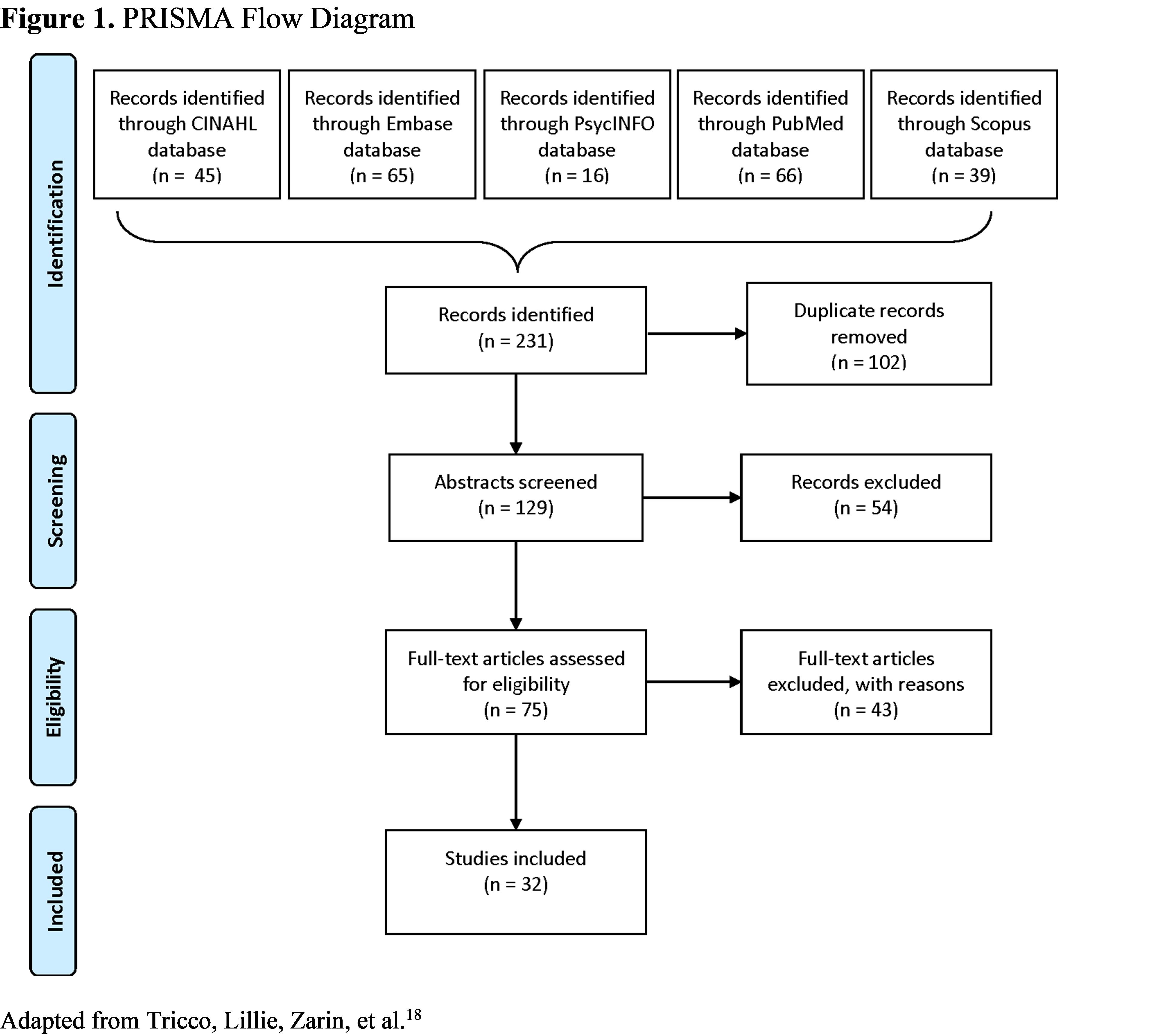
Literature selection was performed by 3 reviewers in 2 steps: (1) review of article title and abstract and (2) review of the full-article text. Each review required reviewer consensus meetings to resolve disagreements. Thirty-two of 129 articles screened were selected for inclusion in this review and evaluated by an analysis team to extract the following data: (1) communities employing ABCR, (2) stages in the CCC,19 (3) cancer types, (4) art forms, and (5) methodologies employed. To classify ABR studies, we identified studies utilizing art as a method of inquiry as “art as research,” studies utilizing art to support qualitative inquiry as “art in research” and investigations of artistic topics as “research about art.”20 Terms describing the data extracted are defined in Table 1.

Results
The majority of the articles (60%) did not specify the Indigenous communities the researchers were working with; therefore, we report our findings by the country in which the ABCR took place. Twenty-one publications (65.6%) reported on research conducted in the United States. Five publications (15.6%) were specific to Australia and 4 publications (12.5%) were specific to Canada. Our results also included one publication specific to New Zealand (3.1%) and one publication specific to Peru (3.1%).
Many publications were not specific to one stage of CCC or cancer type (see Table 2). Publications dealing with survivorship (18.8%) and early detection (15.6%) were the most frequent, followed by publications dealing with prevention (6.3%) and diagnosis and treatment (3.1%). Etiology was not identified in any publications. The most frequently identified cancer types were gynecological, breast, and colorectal cancer.
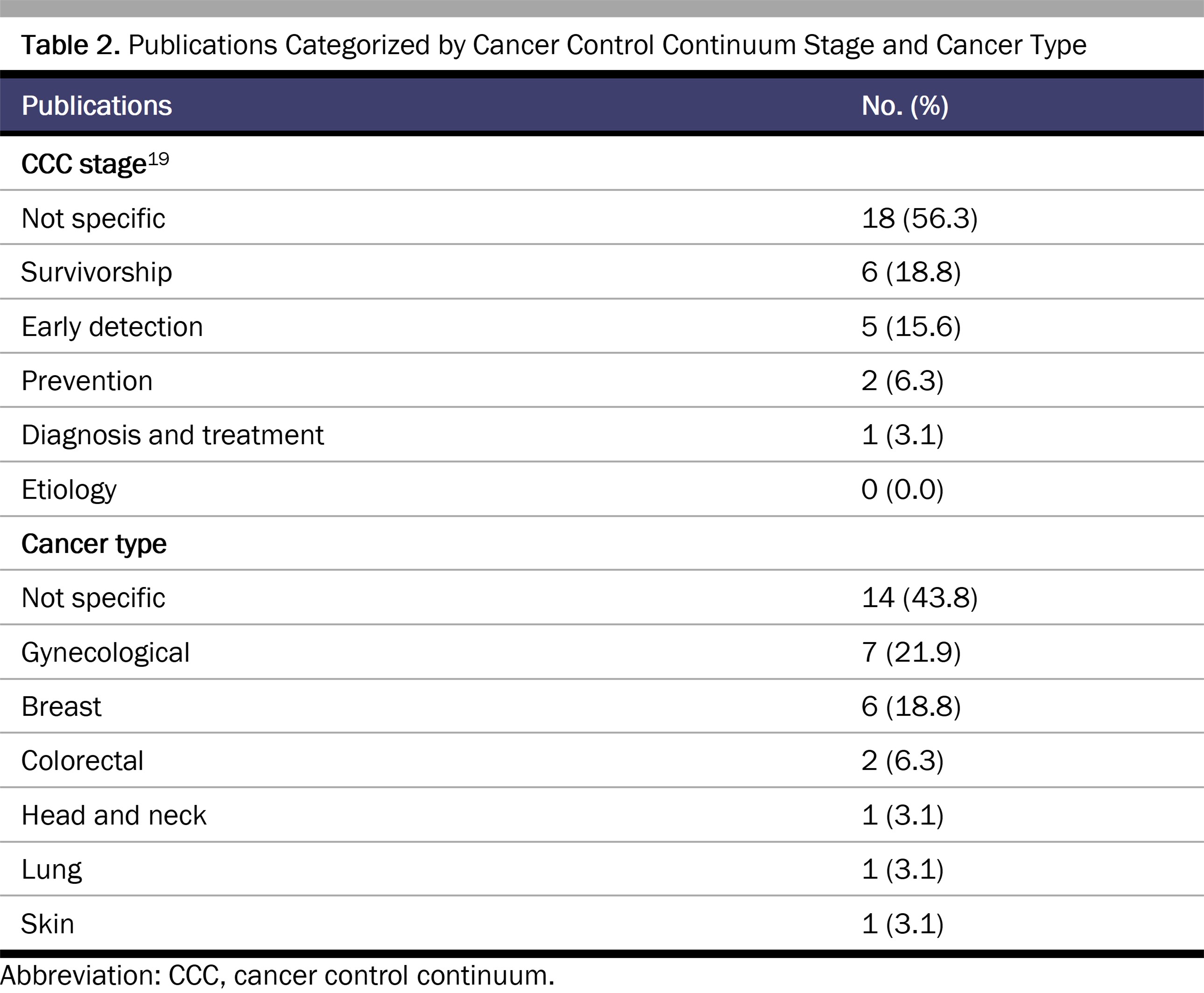
In Table 3, it can be seen that publications dealing with sound art forms, such as telling yarns or stories, were the most frequent (34.4%), followed by multiple forms (21.9%), visual form (18.8%), and new media (15.6%). Publications dealing with performing and literary forms were the least frequent. Over half of the publications utilized art as research (59.4%) as their methodology. In these publications, portraiture, storytelling, and theater served as the inquiry method itself. Research about art was identified in 9 of the selected publications (28.1%). Examples include investigations into the use of video vignettes and informational art cards in interventions. Four publications utilized art in research (12.5%), including drawing accompanied by qualitative inquiry.
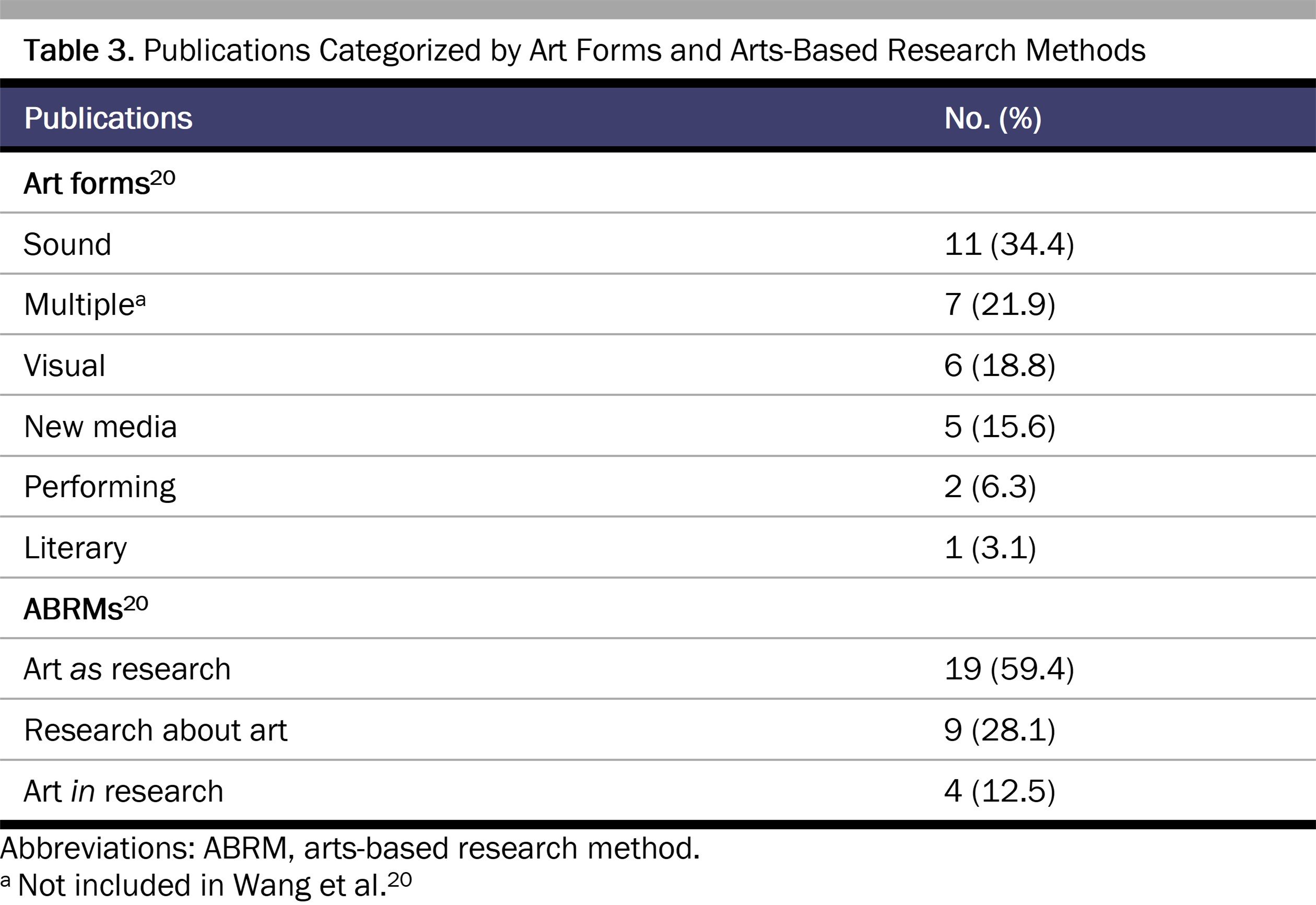
A detailed description of all data extracted from each article can be found in Table 4.
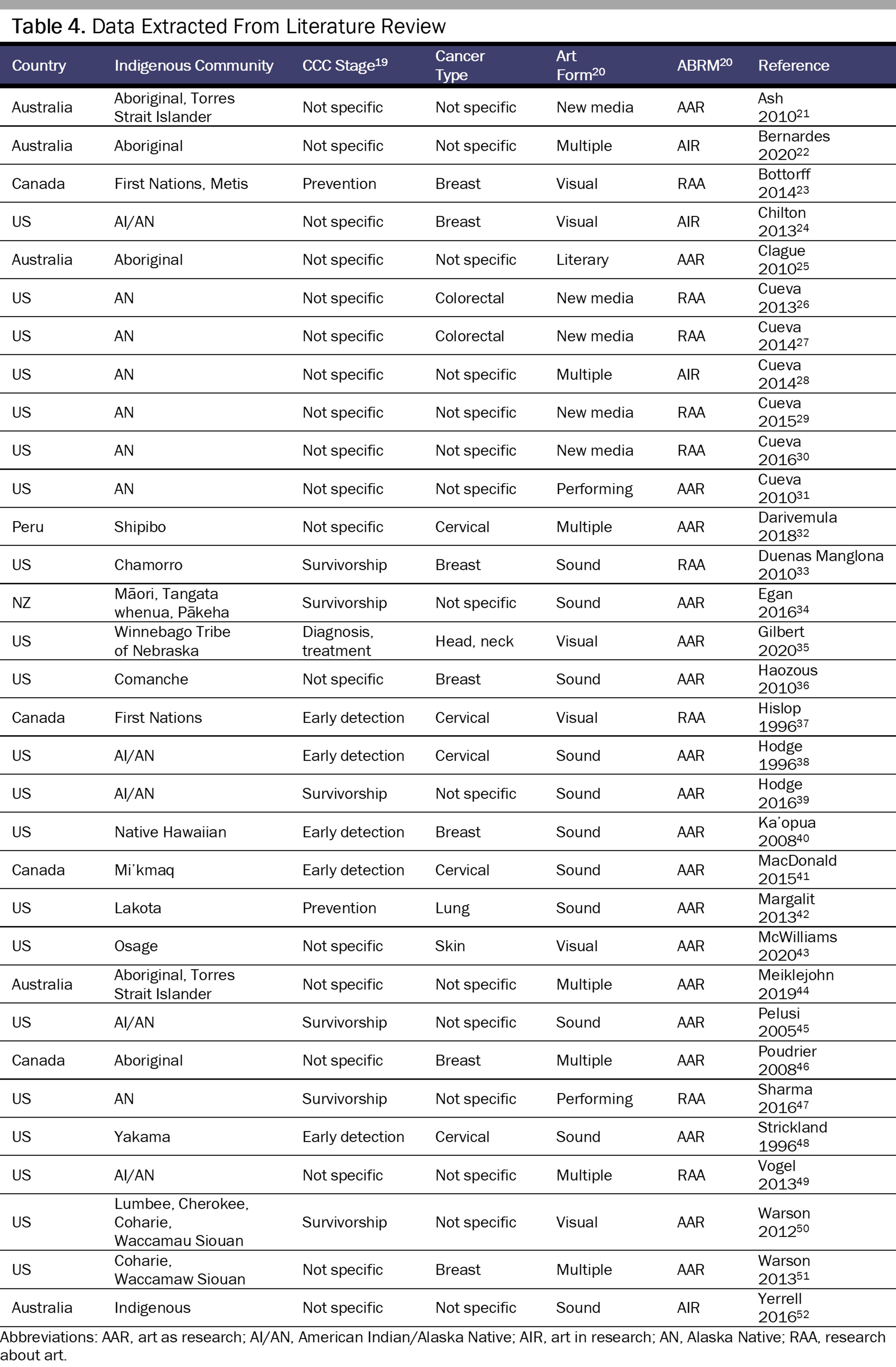
Discussion
Conducting health research and education in culturally relevant ways is vital to their success with Indigenous communities.53 IRMs existed well before precolonization,54 with their own theoretical constructs and protocols that should be respected and acknowledged in research conducted with Indigenous communities.55,56 ABCR aligns with Indigenous knowledge systems in exploring and generating knowledge through painting, drawing, crafting, and storytelling.53 We have identified 4 areas of opportunity to support ABCR with Indigenous populations based on the results of this review.
Extension of ABCR to other Indigenous communities. In the majority of publications in this review, ABCR was conducted in the United States. According to the United Nations,57 Indigenous peoples account for 476 million individuals across 90 countries worldwide. There is an opportunity to apply ABCR methods in other American (eg, the Mayans in Guatemala) or European (eg, the Basque in Spain) communities not found in this review. Furthermore, many publications did not specify the Indigenous communities involved in the research but instead stated the countries where the research occurred. Identifying and acknowledging Indigenous communities not solely by the geographical boundaries created postcolonization but as their own sovereign units of identity would decolonize research and recognize ABCR as an IRM.58
Extension of ABCR to other cancer types. Over half of the articles reviewed were not specific to one cancer type. The conceptualization of cancer as a disease that can spread to many parts of the body is representative of Indigenous worldviews that we are all related.55,59,60,61 This holistic perspective aligns with Indigenous approaches to healing, which include body, mind, and spirit.62,63 There are more than 100 types of cancer,64 yet only 5 cancer types were studied. These included most of the leading causes of cancer deaths in Native Americans. Prostate cancer, however—a leading cause of cancer death among AI/AN men12—was not mentioned and is arguably worth exploration.
Extension of ABCR to all CCC stages. No publications were identified that used ABCR methods to explore cancer etiology. ABCR (eg, art in research) could be integrated in research on cancer etiology examining environmental factors, genetic factors, gene-environment interactions, medication exposures, infectious agents, and health behaviors related to cancer.19 Following the transtheoretical model of health behavior change,65 arts could also be studied as a means to stimulate changes in health behaviors that could help prevent cancer. In this way, ABCR could support prevention efforts at this relatively uninvestigated CCC stage.
Extension of ABCR to other artistic mediums. Sound and multiple art forms were most often employed in ABCR projects with Indigenous populations. Only one article was found utilizing literary art forms. Poetry could be explored as a culturally responsive way to conduct literary-based research that honors Indigenous orality.66,67 Two articles identified performing art forms. Theatre of the Oppressed, a methodology that explores non-oppressive experiences and discusses difficult social topics,68 has been successfully employed with Indigenous populations69 and could be utilized to address cancer. Tecno-sovereignty, an emerging ABR method that examines cross-cultural and intercultural Indigenous innovations from digital media, old electronic analog media, and traditional Indigenous media, is yet another possiblity.70 Integrating literary, performing, and media-based art forms into cancer research could create new methods that align with Indigenous values.70,71
Limitations
Our search terms for ABR methods included prominent methodologies, such as photovoice and storytelling, and, for Indigenous populations, included common regional terms (see Supplementary Appendix). It is possible that not all publications were identified based on the search terms, as these terms are not standardized internationally. Similarly, publications in languages other than English or Spanish were excluded. The CCC model selected did not include end-of-life care and instead included noncurative care in the treatment stage. The literature could be further analyzed to determine ABCR uses in palliative care.
Conclusion
This review details culturally responsive methods of cancer inquiry and education that can be employed with Indigenous populations to enhance research across the CCC. Understanding existing ABCR studies and their effectiveness can guide researchers in designing projects that acknowledge Indigenous knowledge systems and support more ethical ways of generating knowledge. Integrating ABCR can increase the cultural relevance of cancer research, education, and interventions for Indigenous communities. Future qualitative studies to address cancer in Indigenous populations should consider integrating ABCR.
References
-
McNiff S. Art-based research. In Knowles JG, Cole AL, eds. Handbook of the Arts in Qualitative Research: Perspectives, Methodologies, Examples, and Issues. Sage Publications; 2008:29-40.
- Gilbert MA, Lydiatt WM, Aita VA, Robbins RE, McNeilly DP, Desmarais MM. Portrait of a process: arts-based research in a head and neck cancer clinic. Med Humanit. 2016;42(1):57-62.
- Henriksen N, Tjørnhøj-Thomsen T, Hansen HP. Illness, everyday life and narrative montage: the visual aesthetics of cancer in Sara Bro's diary. Health. 2011;15(3):277-297.
- Saarelainen SM. Life tree drawings as a methodological approach in young adults' life stories during cancer remission. Narrative Works. 2015;5(1):68-91.
-
Boehm K, Cramer H, Staroszynski T, Ostermann T. Arts therapies for anxiety, depression, and quality of life in breast cancer patients: a systematic review and meta-analysis. Evid Based Complement Alternat Med. 2014;2014:103297.
- Wright AL, Wahoush O, Ballantyne M, Gabel C, Jack SM. Qualitative health research involving Indigenous peoples: culturally appropriate data collection methods. Qual Rep. 2016;21(12):2230-2245.
-
Cajete GA. Igniting the Sparkle: An Indigenous Science Education Model. Kivaki Press; 1999.
- Wilson D. The significance of a culturally appropriate health service for Indigenous Māori women. Contemp Nurse. 2008;28(1-2):173-188.
- Hammond C, Gifford W, Thomas R, Rabaa S, Thomas O, Domecq MC. Arts-based research methods with Indigenous peoples: an international scoping review. Alternative. 2018;14(3):260-276.
- Moore SP, Forman D, Piñeros M, Fernández SM, de Oliveira Santos M, Bray F. Cancer in Indigenous people in Latin America and the Caribbean: a review. Cancer Med. 2014;3(1):70-80.
- Moore SP, Antoni S, Colquhoun A, et al. Cancer incidence in Indigenous people in Australia, New Zealand, Canada, and the USA: a comparative population-based study. Lancet Oncol. 2015;16(15):1483-1492.
- White MC, Espey DK, Swan J, Wiggins CL, Eheman C, Kaur JS. Disparities in cancer mortality and incidence among American Indians and Alaska Natives in the United States. Am J Public Health. 2014;104(suppl 3):S377-S387.
- Melkonian SC, Jim MA, Haverkamp D, et al. Disparities in cancer incidence and trends among American Indians and Alaska Natives in the United States, 2010-2015. Cancer Epidemiol Biomarkers Prev. 2019;28(10):1604-1611.
- Fisher PA, Ball TJ. Tribal participatory research: mechanisms of a collaborative model. Am J Community Psychol. 2003;32(3-4):207-216.
- Weaver HN. The challenges of research in Native American communities: incorporating principles of cultural competence. J Soc Serv Res. 1997;23(2):1-5.
- Schroepfer TA, Matloub J, Creswell P, Strickland R, Anderson DM. A community-specific approach to cancer research in Indian country. Prog Community Health Partnersh. 2009;3(4):317-325.
- Idoate R, Gilbert M, King KM, et al. Urban American Indian community health beliefs associated with addressing cancer in the Northern Plains Region. J Cancer Educ. 2021;36(5):996-1004.
- Tricco AC, Lillie E, Zarin W, et al. PRISMA extension for scoping reviews (PRISMA-ScR): checklist and explanation. Ann Intern Med. 2018;169(7):467-473.
-
Cancer control continuum. Division of Cancer Control and Population Sciences, National Cancer Institute, National Institutes of Health. Accessed December 3, 2021. cancercontrol.cancer.gov/about-dccps/about-cc/cancer-control-continuum
- Wang Q, Coemans S, Siegesmund R, Hannes K. Arts-based methods in socially engaged research practice: a classification framework. Art Res Int. 2017;2(2):5-39.
-
Ash K, Devilee L, Prior D, Yates P, Yokowo D, Australia C. Development of a learning resource for nurses caring for Aboriginal and Torres Strait Islander peoples affected by cancer. Asia Pac J Clin Oncol. 2010;6:231.
-
Bernardes CM, Valery PC, Arley B, Pratt G, Medlin L, Meiklejohn JA. Empowering voice through the creation of a safe space: an experience of Aboriginal women in regional Queensland. Int J Environ Res Public Health. 2020;17(5):1476.
- Bottorff JL, Haines-Saah R, Oliffe JL, et al. Designing tailored messages about smoking and breast cancer: a focus group study with youth. Can J Nurs Res. 2014;46(1):66-86.
- Chilton JA, Downing C, Lofton M, et al. Circle of Sisters: raising awareness of Native American women to breast cancer. J Health Care Poor Underserved. 2013;24(3):1167-1179.
-
Clague L, Langford M, Sundquist K, et al. Aboriginal cancer journeys: storytelling to support Aboriginal people affected by cancer. Asia Pac J Clin Oncol. 2010;6:210.
- Cueva M, Cueva K, Dignan M, Lanier A, Kuhnley R. Evaluating arts-based cancer education using an internet survey among Alaska community health workers. J Cancer Educ. 2014;29(3):529-535.
- Cueva M, Dignan M, Lanier A, Kuhnley R. Qualitative evaluation of a colorectal cancer education CD-ROM for community health aides/practitioners in Alaska. J Cancer Educ. 2014;29(4):613-618.
-
Cueva M, Kuhnley R, Revels L, Schoenberg NE, Dignan M. Digital storytelling: a tool for health promotion and cancer awareness in rural Alaskan communities. Int J Circumpolar Health. 2015;74(1):28781.
- Cueva M, Kuhnley R, Revels L, Schoenberg NE, Lanier A, Dignan M. Engaging elements of cancer-related digital stories in Alaska. J Cancer Educ. 2016;31(3):500-505.
-
Cueva M, Kuhnley R, Slatton J, Dignan M, Underwood E, Landis K. Telenovela: an innovative colorectal cancer screening health messaging tool. Int J Circumpolar Health. 2013;72(1):21301.
- Cueva M. Readers' theatre as cancer education: an organic inquiry in Alaska awakening possibilities in a living spiral of understanding. J Cancer Educ. 2010;25(1):3-8.
- Darivemula S, Rao A, Wilkinson-Ryan I, et al. Perspective on traditional and western models of health literacy on cervical cancer prevention for Shipibo women. Fam Dr. 2018;7(2):18-21.
- Egan R, Llewellyn R, Wood S, et al. The Cancer Stories Project: narratives of encounters with cancer in Aotearoa, New Zealand. Psychooncology. 2016;25(3):300-307.
- Gilbert M, Idoate R, Desmarais MM, Lydiatt WM. Anthony and the role of silence in portraiture in clinical settings. AMA J Ethics. 2020;22(6):E488-E498.
- Haozous EA, Eschiti V, Lauderdale J, Hill C, Amos C. Use of the talking circle for Comanche women's breast health education. J Transcult Nurs. 2010;21(4):377-385.
-
Hislop TG, Clarke HF, Deschamps M, et al. Cervical cytology screening. How can we improve rates among First Nations women in urban British Columbia? Can Fam Physician. 1996;42:1701-1708.
- Hodge FS, Cadogan M, Itty TL, Williams A, Finney A. Culture-broker and medical decoder: contributions of caregivers in American Indian cancer trajectories. J Community Support Oncol. 2016;14(5):221-228.
- Hodge FS, Fredericks L, Rodriguez B. American Indian women's talking circle. A cervical cancer screening and prevention project. Cancer. 1996;78(7)(suppl):1592-1597.
- Ka’opua LS. Developing a culturally responsive breast cancer screening promotion with Native Hawaiian women in churches. Health Soc Work. 2008;33(3):169-177.
- MacDonald C, Martin-Misener R, Steenbeek A, Browne A. Honouring stories: Mi’kmaq women's experiences with Pap screening in Eastern Canada. Can J Nurs Res. 2015;47(1):72-96.
- Margalit R, Watanabe-Galloway S, Kennedy F, et al. Lakota elders' views on traditional versus commercial/addictive tobacco use; oral history depicting a fundamental distinction. J Community Health. 2013;38(3):538-545.
- McWilliams B, Idoate R. Portraits of Suzanne, an Osage woman's story of loving the sun and living with skin cancer. AMA J Ethics. 2020;22(6):E557-E564.
-
Meiklejohn JA, Arley BD, Pratt G, Valery PC, Bernardes CM. “We just don’t talk about it”: Aboriginal and Torres Strait Islander people's perceptions of cancer in regional Queensland. Rural Remote Health. 2019;19(2):4789.
- Palacios JF, Salem B, Hodge FS, Albarrán CR, Anaebere A, Hayes-Bautista TM. Storytelling: a qualitative tool to promote health among vulnerable populations. J Transcult Nurs. 2015;26(4):346-353.
- Pelusi J, Krebs LU, Castro L. Understanding cancer—understanding the stories of life and living. J Cancer Educ. 2005;20(1)(suppl):12-16.
- Poudrier J, Mac-Lean RT. “We’ve fallen into the cracks”: Aboriginal women's experiences with breast cancer through photovoice. Nurs Inq. 2009;16(4):306-317.
-
Sharma DKB. Dance/Movement Therapy (DMT) for Cancer Survivors and Caregivers in Fairbanks. Doctoral thesis. University of Alaska; 2016. Accessed May 20, 2022. https://scholarworks.alaska.edu/bitstream/handle/11122/6875/Sharma_uaf_0006E_10514.pdf?sequence=1&isAllowed=y
- Strickland CJ, Chrisman NJ, Yallup M, Powell K, Squeoch MD. Walking the journey of womanhood: Yakama Indian women and Papanicolaou (Pap) test screening. Public Health Nurs. 1996;13(2):141-150.
- Vogel O, Cowens-Alvarado R, Eschiti V, et al. Circle Of Life cancer education: giving voice to American Indian and Alaska Native communities. J Cancer Educ. 2013;28(3):565-572.
-
Warson E. Healing across cultures: arts in health care with American Indian and Alaska Native cancer survivors. In: Malchiodi CA, ed. Trauma and Expressive Arts Therapy: Brain, Body, and Imagination in the Healing Process. Guilford Press; 2013:162-183.
- Warson E. Healing pathways: art therapy for American Indian cancer survivors. J Cancer Educ. 2012;27(1)(suppl):S47-S56.
-
Yerrell PH, Roder D, Cargo M, et al. Cancer data and Aboriginal disparities (CanDAD)—developing an advanced cancer data system for Aboriginal people in South Australia: a mixed methods research protocol. BMJ Open. 2016;6(12):e012505.
- Browne AJ, Smye VL, Varcoe C. The relevance of postcolonial theoretical perspectives to research in Aboriginal health. Can J Nurs Res. 2005;37(4):16-37.
- Elk LB. Native science: understanding and respecting other ways of thinking. Rangelands. 2016;38(1):3-4.
-
Cajete GA. Native Science: Natural Laws of Interdependence. Clear Light Publishing; 2000.
-
Wilson S. Research Is Ceremony: Indigenous Research Methods. Fernwood Press; 2008.
-
10 things to know about Indigenous peoples. United Nations Development Programme. July 29, 2021. Accessed February 4, 2022. https://stories.undp.org/10-things-we-all-should-know-about-indigenous-people
- Flicker S, Danforth JY, Wilson C, et al. “Because we have really unique art”: decolonizing research with Indigenous youth using the arts. Int J Indig Health. 2014;10(1):16-34.
- Braun KL, Browne CV, Ka’opua LS, Kim BJ, Mokuau N. Research on Indigenous elders: from positivistic to decolonizing methodologies. Gerontologist. 2021;54(1):117-126.
-
Denzin NK, Lincoln YS, Smith LT, eds. Handbook of Critical and Indigenous Methodologies. Sage Publications; 2008.
-
Kovach M. Indigenous Methodologies, Characteristics, Conversations and Contexts. University of Toronto Press; 2010.
- Hodge DR, Limb GE, Cross TL. Moving from colonization toward balance and harmony: a Native American perspective on wellness. Soc Work. 2009;54(3):211-219.
- Struthers R, Eschiti VS, Patchell B. Traditional Indigenous healing: part I. Complement Ther Nurs Midwifery. 2004;10(3):141-149.
-
What is cancer. National Cancer Institute, National Institutes of Health. April 21, 2021. Accessed December 3, 2021. https://www.cancer.gov/about-cancer/understanding/what-is-cancer
- Prochaska JO, Velicer WF. The transtheoretical model of health behavior change. Am J Health Promot. 1997;12(1):38-48.
-
Faulkner SL. Poetry as Method: Reporting Research Through Verse. Routledge; 2016.
- Saunders V, West R, Usher K. Applying Indigenist research methodologies in health research: experiences in the Borderlands. Aust J Indig Educ. 2010;39(suppl 1):1-7.
- Österlind E. Acting out of habits—can Theatre of the Oppressed promote change? Boal's theatre methods in relation to Bourdieu's concept of habitus. Res Drama Educ. 2008;13(1):71-82.
-
Driskill QL. Mothertongue: incorporating Theatre of the Oppressed into language restoration movements. In: Reyhner J, Trujilo OV, Carrasco RL, Lockard L, eds. Nurturing Natives Languages. Northern Arizona University; 2003:155-163.
-
Martinez CC. Tecno-Sovereignty: An Indigenous Theory and Praxis of Media Articulated Through Art, Technology, and Learning. Doctoral thesis. Arizona State University; 2015. Accessed May 20, 2022. https://keep.lib.asu.edu/_flysystem/fedora/c7/131861/Martinez_asu_0010E_14942.pdf
-
Mundy P. Indigenous knowledge and communication: current approaches. May 1993. Accessed March 29, 2022. https://citeseerx.ist.psu.edu/viewdoc/download?doi=10.1.1.95.2391&rep=rep1&type=pdf
